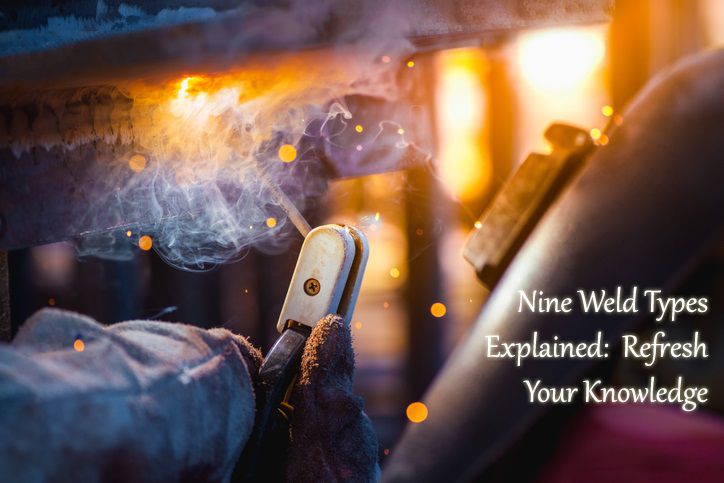
9 Weld Types
As a welder, your performance can be greatly improved, as well as your ability to troubleshoot any, if not all, welding problems, through a knowledge refresher and a further deepening of your understanding of welds applied to joint designs. And, while most welders will already know and understand the different types, a refresher is always good to enhance welding capabilities, and with this, let’s look into nine different weld types.
As we are sure you know, welds are best explained and described by their shape and are performed on structures in this shapely position. Welding techniques are then created to allow welding in any position, with some welding processes boasting all-position capabilities. However, it is important to note that some welding processes are only used in one or two positions. Basically, all types of welds are distinguished according to their workpiece positioning or, alternatively, the position of the welded joint on the section or plate.
Fillet Welds And Groove Welds
Fillet and groove welds are the two most common types of weld. Fillet weld types are specifically used to join metals at a 90-degree angle, or otherwise used to join two surfaces at a right angle to each other, and adding material mainly to the joint surface. A fillet weld forms the first main category of welds. There are different types of fillet welds including full fillet welds, staggered intermittent fillet welds, and chain intermittent fillet welds. For more information on these, contact us at MuggyWeld. This type of weld sits on top of perpendicular surfaces and is not designed to penetrate into a joint. Essentially, it is a right triangle in a section.
The second main category of welds come in the form of groove welds which penetrate right into the joint. Groove welds are used to connect butt joints and deposit welding material directly into the groove. When made on sheet metals or on plates, and connecting two ends of a piece of pipe or tubing, groove welds can be applied to other types of joints as well. There are different types of groove welds, as we all should know, including square groove welds, single-v groove welds, single-bevel groove welds, single-u groove welds and single-j groove welds. Good to note that whatever type of weld is used will essentially determine the manner in which the joint, surface and seam is prepared.
Surfacing Welds
Surfacing welds build up worn metal on surfaces and when working with square butt joints. This type of weld comprises one or more weave beads or strings which are deposited on an unbroken surface in order to achieve desired dimensions or properties.
Plug Welds And Slot Welds
Now we get to plug welds and slot welds. Simple to make, at MuggyWeld we know that circular plug welds are used when you have two overlapping metal pieces, and you don’t want to see the weld or when you need clearance for another piece of metal. Plug welds are a round weld that is made inside an existing hole, most commonly in one piece of metal and is a welding technique that pieces together material members or tee joints. These types of welds are sometimes used in place of rivets as well.
Now we get to slot welds. A slot weld is created within an elongated hole and joins the surface of a piece of material or tee joint to another piece through an elongated hole.If you didn’t know already, the hole can then be opened at one end and partially or completely filled with weld material if needed.
Upset Welds And Flash Welds
Upset welds, otherwise known as resistance butt welds, is a weld technique that creates coalescence simultaneously over the whole area of abutting surfaces or progressively along a joint, through the heat obtained from resistance to electric current through the area where those surfaces are connected. Then, when it comes to a flash weld, this type of welding uses equipment that comprises both a movable and fixed clamp, forcing and gripping the pieces together. A single-turn secondary of a heavy-duty AC transformer is performed when a voltage of five is applied at the clamps and the parts are connected. The points of contact are fused together, creating short-lived arcs while generating interface heat. Molten metal at the interface is expelled as ‘flash’ and the moving platen is advanced to keep a constant gap until a suitable temperature has been reached at the interface. The parts are then effectively forged together.
Seam Welds And Spot Welds
Seam welding is the joining of workpieces made of similar or dissimilar materials along a continuous seam. This type of weld, or welding technique, can be broken down into two main techniques, resistance seam welding, and friction seam welding. Spot welding, in basic terms, is a type of electric resistance welding or a type of weld that is used to weld various sheet metal products through an effective process in which contacting metal surface points are joined by the heat obtained from resistance to electric current.
Now that you have a refreshed understanding of these nine weld types, you’re sure to improve your performance as well as your ability to troubleshoot any, if not all, welding problems. Should you need further information about weld types and techniques – or anything regarding welding, contact us at MuggyWeld.
